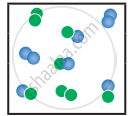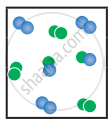Advertisements
Advertisements
प्रश्न
The equilibrium for the dissociation of XY2 is given as,
\[\ce{2 XY2 (g) <=> 2 XY (g) + Y2 (g)}\]
if the degree of dissociation x is so small compared to one. Show that 2 Kp = PX3 where P is the total pressure and Kp is the dissociation equilibrium constant of XY2.
उत्तर
\[\ce{2 XY2 (g) <=> 2 XY (g) + Y2 (g)}\]
| XY2 | XY | Y2 | |
| Initial no. of. moles | 1 | - | - |
| No. of. moles dissociated | x | - | - |
| No. of. moles at equilibrium | (1 - x) 1 | x | `"x"/2` |
Total no. of moles = `1 - x + x + x/2 = 1 + x/2 ≅ 1`
[∵ Given that x << 1; 1 - x ≅ 1 and 1 + `x/2` ≅ 1]
`"K"_"p" = (["P"_"xy"]^2["P"_("Y"_2)])/["P"_("XY"_2)]^2`
`= ((x/1 xx "P")^2((x//2)/1 xx "P"))/(1/1 xx "P")^2`
`"K"_"P" = (x^2"P"^2 xx "P")/(2"P"^2)`; 2Kp = x3P
APPEARS IN
संबंधित प्रश्न
`"K"_"C"/"K"_"P"` for the reaction,
\[\ce{N2(g) + 3H2(g) <=> 2NH3(g)}\] is
The equilibrium constants of the following reactions are:
\[\ce{N2 + 3H2 <=> 2NH3}\]; K1
\[\ce{N2 + O2 <=> 2NO}\]; K2
\[\ce{H2 + 1/2O2 <=> H2O}\]; K3
The equilibrium constant (K) for the reaction;
\[\ce{2NH3 + 5/2 O2 <=> 2NO + 3H2O}\], will be
For a given reaction at a particular temperature, the equilibrium constant has a constant value. Is the value of Q also constant? Explain.
What is the relation between Kp and Kc? Given one example for which Kp is equal to Kc.
For the reaction, \[\ce{A2(g) + B2(g) <=> 2AB(g); \Delta H}\] is -ve.
the following molecular scenes represent differenr reaction mixture. (A-green, B-blue)
| Closed ← |
 |
 |
 |
| System | At equilibrium | (x) | (y) |
- Calculate the equilibrium constant Kp and (Kc).
- For the reaction mixture represented by scene (x), (y) the reaction proceed in which directions?
- What is the effect of an increase in pressure for the mixture at equilibrium?
Derive a general expression for the equilibrium constant Kp and Kc for the reaction, \[\ce{3H2(g) + N2(g) <=> 2NH3(g)}\].
For the reaction
\[\ce{SrCO3(s) <=> SrO(s) + CO2(g)}\]
the value of equilibrium constant Kp = 2.2 × 10-4 at 1002 K. Calculate Kc for the reaction.
To study the decomposition of hydrogen iodide, a student fills an evacuated 3 litre flask with 0.3 mol of HI gas and allows the reaction to proceed at 500°C. At equilibrium he found the concentration of HI which is equal to 0.05 M. Calculate Kc and Kp.
1 mol of CH4, 1 mole of CS2 and 2 mol of H2S are 2 mol of H2 are mixed in a 500 ml flask. The equilibrium constant for the reaction Kc = 4 x 10-2 mol2 lit-2. In which direction will the reaction proceed to reach equilibrium?
At particular temperature Kc = 4 × 10-2 for the reaction, \[\ce{H2S (g) <=> H2(g) +1/2 S2(g)}\]. Calculate the Kc for the following reaction.
\[\ce{3H2S (g) <=> 3H2 (g) + 3/2 S2 (g)}\]
